4.6 Chromosomal Disorders
Inherited disorders can arise when chromosomes behave abnormally during meiosis. Chromosome disorders can be divided into two categories: chromosome number abnormalities and structural rearrangements. Because even small segments of chromosomes can span many genes, chromosomal disorders are characteristically dramatic and often fatal.
Disorders in Chromosome Number
The isolation and microscopic observation of chromosomes form the basis of cytogenetics and is the primary method by which clinicians detect chromosomal abnormalities in humans. A karyotype is the number and appearance of chromosomes, including their length, banding pattern, and centromere position. To obtain a view of an individual’s karyotype, cytologists photograph the chromosomes and then cut and paste each chromosome into a chart or karyogram (see figure below).

Geneticists Use Karyograms to Identify Chromosomal Aberrations
The karyotype is a method by which traits characterized by chromosomal abnormalities can be identified from a single cell. A person’s cells (like white blood cells) are first collected from a blood sample or other tissue to observe an individual’s karyotype. In the laboratory, the isolated cells are stimulated to begin actively dividing. A chemical is then applied to the cells to arrest mitosis during metaphase. The cells are then fixed to a slide.
The geneticist then stains chromosomes with one of several dyes to better visualize each pair’s distinct and reproducible banding patterns. Following staining, chromosomes are viewed using bright-field microscopy. An experienced cytogeneticist can identify each band. In addition to the banding patterns, chromosomes are further determined based on size and centromere location. The geneticist obtains a digital image, identifies each chromosome, and manually arranges the chromosomes into this pattern to get the classic depiction of the karyotype in which homologous pairs of chromosomes are aligned in numerical order from longest to shortest.
At its most basic, the karyogram may reveal genetic abnormalities in which an individual has too many or too few chromosomes per cell. Examples of this are Down syndrome, identified by a third copy of chromosome 21, and Turner syndrome, characterized by the presence of only one X chromosome in women instead of two. Geneticists can also identify large deletions or insertions of DNA. For instance, Jacobsen syndrome, which involves distinctive facial features as well as heart and bleeding defects, is determined by a deletion on chromosome 11. Finally, the karyotype can pinpoint translocations, which occur when a segment of genetic material breaks from one chromosome and reattaches to another or a different part of the same chromosome. Translocations are implicated in certain cancers, including chronic myelogenous leukemia.
By observing a karyogram, geneticists can visualize an individual’s chromosomal composition to confirm or predict genetic abnormalities in offspring even before birth.
Nondisjunctions, Duplications, and Deletions
Of all the chromosomal disorders, abnormalities in chromosome number are the most easily identifiable from a karyogram. Disorders of chromosome number include the duplication or loss of entire chromosomes and changes in the number of complete sets of chromosomes. They are caused by nondisjunction, which occurs when pairs of homologous chromosomes or sister chromatids fail to separate during meiosis. The risk of nondisjunction increases with the age of the parents.
Nondisjunction can occur during either meiosis I or II, with different results (see figure below). If homologous chromosomes fail to separate during meiosis I, the result is two gametes that lack that chromosome and two gametes with two copies of the chromosome. If sister chromatids fail to separate during meiosis II, the result is one gamete that lacks that chromosome, two normal gametes with one copy of the chromosome, and one gamete with two copies.
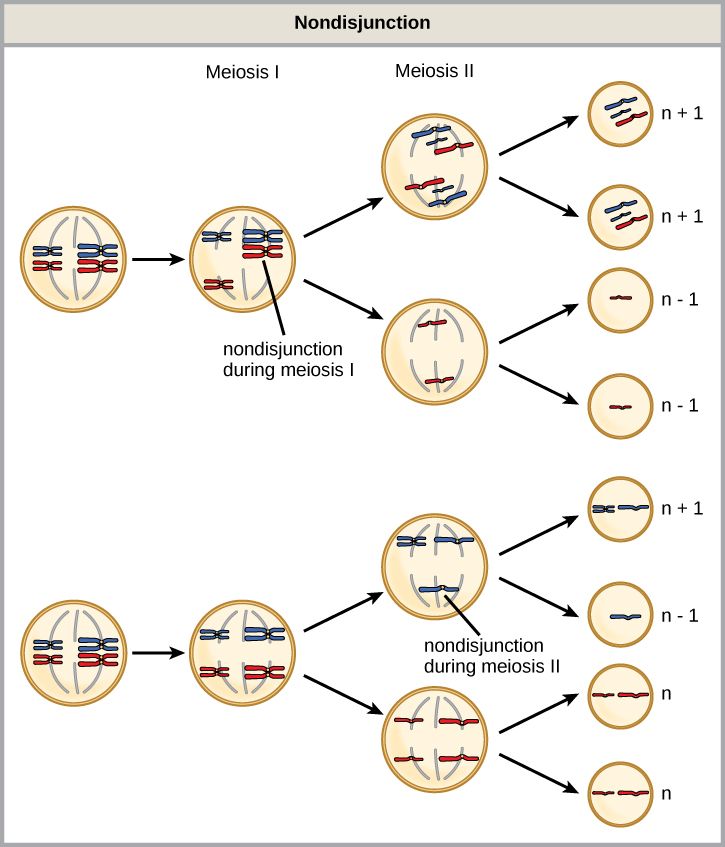
An individual with the appropriate number of chromosomes for their species is called euploid; in humans, euploidy corresponds to 22 pairs of autosomes and one pair of sex chromosomes. An individual with an error in chromosome number is described as aneuploid, a term that includes monosomy (loss of one chromosome) or trisomy (gain of an extraneous chromosome). Monosomic human zygotes missing any one copy of an autosome invariably fail to develop to birth because they have only one copy of essential genes. Most autosomal trisomies also fail to develop to birth; however, duplications of some smaller chromosomes (13, 15, 18, 21, or 22) can result in offspring that survive for several weeks to many years. Trisomic individuals suffer from a different genetic imbalance: an excess gene dose. Cell functions are calibrated to the amount of gene product produced by two copies (doses) of each gene; adding a third copy (dose) disrupts this balance. The most common trisomy is that of chromosome 21, which leads to Down syndrome. Individuals with this inherited disorder have characteristic physical features and developmental delays in growth and cognition. The incidence of Down syndrome is correlated with maternal age, such that childbearing people over the age of 35 experience an increased probability of giving birth to children with Down syndrome (see figure below). It should be noted that the majority of children with Down syndrome are born to mothers under 35, likely because pre-natal screening for those over 35 is common. The probability related to age and the actual incidence are separate and distinct.
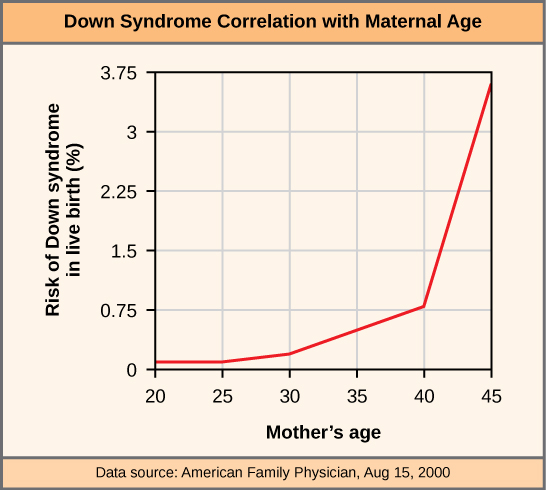
Concept in Action
Visualize the various outcomes of nondisjunction in this animation.
Watch Chromosome Nondisjunction Animation (5 mins) on YouTube
Video source: Shomu’s Biology Academy. (2016, April 14). Chromosome nondisjunction animation [Video]. YouTube. https://www.youtube.com/watch?v=4bzY9e-YQqI
Humans display dramatic deleterious effects with autosomal trisomies and monosomies. Therefore, it may seem counterintuitive that human females and males can function normally despite carrying different numbers of the X chromosome. In part, this occurs because of a process called X inactivation. Early in development, when female mammalian embryos consist of just a few thousand cells, one X chromosome in each cell inactivates by condensing into a Barr body structure. The genes on the inactive X chromosome are not expressed. The particular X chromosome (maternally or paternally derived) that is inactivated in each cell is random, but once the inactivation occurs, all cells descended from that cell will have the same inactive X chromosome. By this process, females compensate for their double genetic dose of X chromosome.
In so-called “tortoiseshell” cats, X inactivation is observed as coat-colour variegation (see figure below). Females heterozygous for an X-linked coat colour gene will express one of two different coat colours over other regions of their body, corresponding to whichever X chromosome is inactivated in the embryonic cell progenitor of that region. When you see a tortoiseshell cat, you will know it must be a female.

In an individual carrying an abnormal number of X chromosomes, cellular mechanisms will inactivate all but one X in each cell. As a result, X-chromosomal abnormalities are typically associated with mild mental and physical defects and sterility. If the X chromosome is absent altogether, the individual will not develop.
Several errors in sex chromosome numbers have been characterized. Individuals with three X chromosomes, called triple-X, appear female but express developmental delays and reduced fertility. The XXY chromosome complement, corresponding to one type of Klinefelter syndrome, corresponds to male individuals with small testes, enlarged breasts, and reduced body hair. The extra X chromosome undergoes inactivation to compensate for the excess genetic dosage. Turner syndrome, characterized as an X0 chromosome complement (i.e., only a single sex chromosome), corresponds to a female individual with short stature, webbed skin in the neck region, hearing and cardiac impairments, and sterility.
An individual with more than the correct number of chromosome sets (two for diploid species) is called polyploid. For instance, fertilizing an abnormal diploid egg with a normal haploid sperm would yield a triploid zygote. Polyploid animals are scarce, with only a few examples among the flatworms, crustaceans, amphibians, fish, and lizards. Triploid animals are sterile because meiosis cannot proceed normally with an odd number of chromosome sets. In contrast, polyploidy is very common in the plant kingdom, and polyploid plants tend to be larger and more robust than euploids of their species.
Chromosome Structural Rearrangements
Cytologists have characterized numerous structural rearrangements in chromosomes, including partial duplications, deletions, inversions, and translocations. Duplications and deletions often produce offspring that survive but exhibit physical and mental abnormalities. Cri-du-chat (from the French for “cry of the cat”) is a syndrome associated with nervous system abnormalities and identifiable physical features that result from a deletion of most of the small arm of chromosome 5 (see figure below). Infants with this genotype emit a characteristic high-pitched cry upon which the disorder’s name is based.
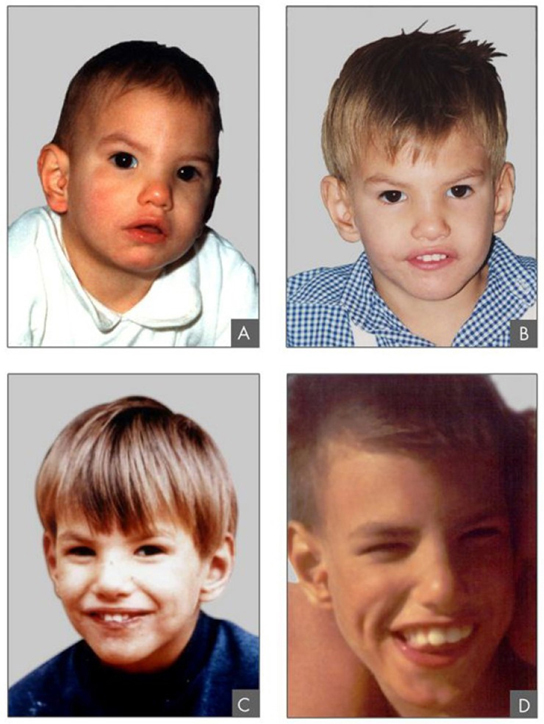
Chromosome inversions and translocations can be identified by observing cells during meiosis because homologous chromosomes with a rearrangement in one of the pairs must contort to maintain appropriate gene alignment and pair effectively during prophase I.
A chromosome inversion is the detachment, 180° rotation, and reinsertion of part of a chromosome. Unless they disrupt a gene sequence, inversions only change the orientation of genes and are likely to have milder effects than aneuploid errors.
A translocation occurs when a chromosome segment dissociates and reattaches to a different, nonhomologous chromosome. Translocations can be benign or have devastating effects, depending on how the positions of genes are altered concerning regulatory sequences. Notably, specific translocations have been associated with several cancers and with schizophrenia. Reciprocal translocations result from the exchange of chromosome segments between two nonhomologous chromosomes such that there is no gain or loss of genetic information (see figure below).
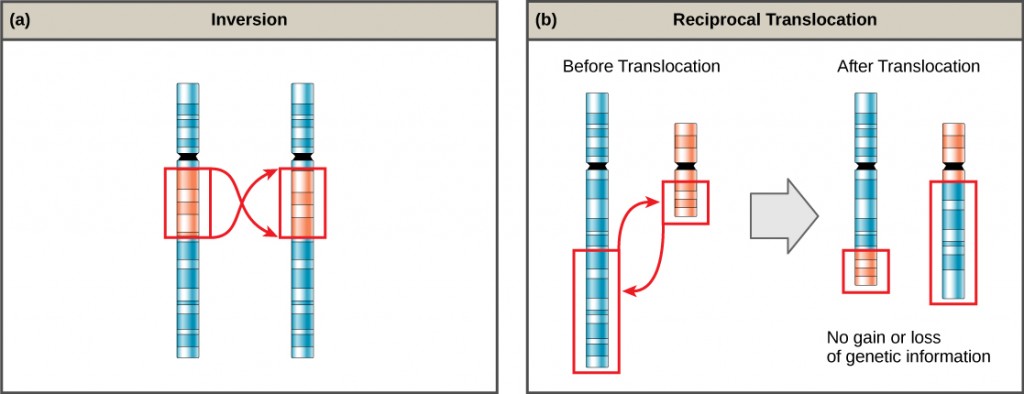
When an individual’s cells differ in their chromosomal makeup, it is known as chromosomal mosaicism.
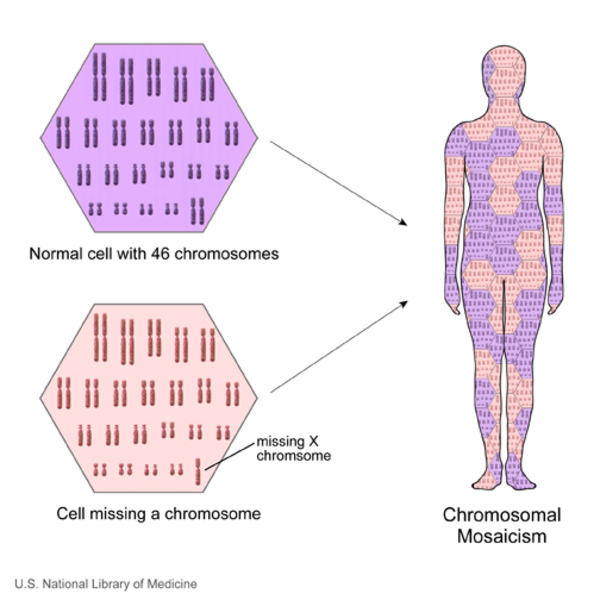
Chromosomal mosaicism occurs from an error in cell division in cells other than eggs and sperm. Most commonly, some cells end up with one extra or missing chromosome (for a total of 45 or 47 chromosomes per cell), while other cells have 46 chromosomes. Mosaic Turner syndrome is one example of chromosomal mosaicism. In females with this condition, some cells have 45 chromosomes because they are missing one copy of the X chromosome, while other cells have the usual number of chromosomes.
Many cancer cells also have changes in their number of chromosomes. These changes are not inherited; they occur in somatic cells (cells other than eggs or sperm) during the formation or progression of a cancerous tumour.
Attribution & References
Except where otherwise noted, this page is adapted from:
- 7.3 Errors in Meiosis In Concepts of Biology – 1st Canadian Edition by Charles Molnar and Jane Gair, CC BY 4.0 . / A derivative of Concepts of Biology (OpenStax), CC BY 4.0. Access Concepts of Biology for free at OpenStax

